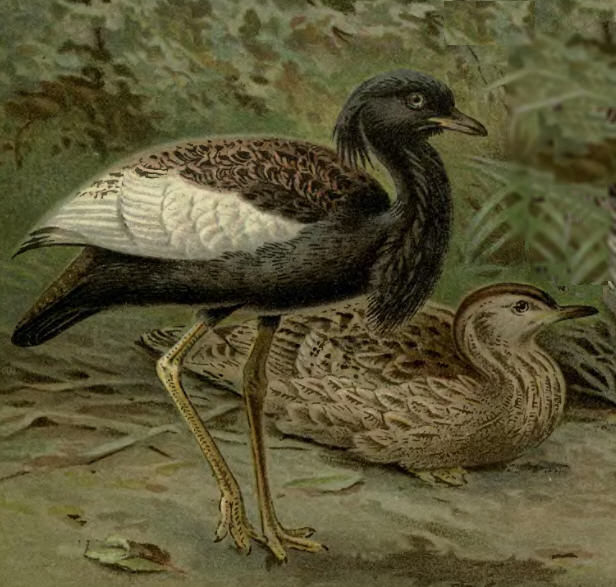Bengal Florican (Houbaropsis bengalensis) - Wiki Bengal Florican
From Wikipedia, the free encyclopedia
Order: Gruiformes
Family: Otididae
[Photo] Bengal Florican (Houbaropsis bengalensis). Male (standing) and female. Source: Lydekker, R. 1895 The Royal Natural History. Volume 4. Frederick Warne and Co. (from www.archive.org). Date: 1895. Author: Richard Lydekker.
The Bengal Florican, Houbaropsis bengalensis, is a bustard, the only member of the genus Houbaropsis. It has two disjunct populations, one in the Indian subcontinent, another in South East Asia. The former occurs from Uttar Pradesh, India, through the terai of Nepal, to Assam and Arunachal Pradesh, India, and historically to Bangladesh. The South East Asian population occurs in Cambodia and adjacent southern Vietnam.
The male has black from head to neck and underparts. Upperparts are buff with fine black vermiculations and black arrowhead markings, and it has a conspicuous white patch on the wing coverts. Females are larger than the male and have a buff brown colour, with a dark brown crown and narrow dark streak down the side of the neck.
They are normally silent but when disturbed utters a metallic chik-chik-chik call.
They are usually seen in the early mornings and evenings and are especially easily spotted in the breeding season of March to August. They live in open tall grassland habitats with scattered bushes.
It is declining dramatically and only survives in small, highly fragmented populations (220-280 birds in India and up to 100 in Nepal). Consequently, it is uplisted from Endangered to Critically Endangered status in the 2007 IUCN Red List.
http://en.wikipedia.org/wiki/Bengal_Florican
| The text in this page is based on the copyrighted Wikipedia article shown in above URL. It is used under the GNU Free Documentation License. You may redistribute it, verbatim or modified, providing that you comply with the terms of the GFDL. |
